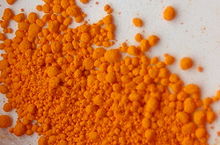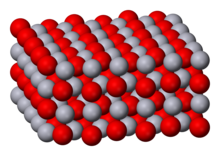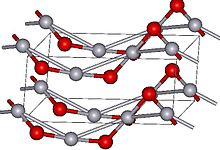Mercury(II) oxide
 | |
 | |
| Names | |
|---|---|
| IUPAC name
Mercury(II) oxide
| |
| Other names | |
| Identifiers | |
3D model (JSmol)
|
|
| ChemSpider | |
| ECHA InfoCard | 100.040.580 |
| KEGG | |
PubChem CID
|
|
| RTECS number |
|
| UNII | |
| UN number | 1641 |
CompTox Dashboard (EPA)
|
|
| |
| |
| Properties | |
| HgO | |
| Molar mass | 216.591 g·mol−1 |
| Appearance | Yellow or red solid |
| Odor | odorless |
| Density | 11.14 g/cm3 |
| Melting point | 500 °C (932 °F; 773 K) (decomposes) |
| 0.0053 g/100 mL (25 °C) 0.0395 g/100 mL (100 °C) | |
| Solubility | insoluble in alcohol, ether, acetone, ammonia |
| Band gap | 2.2 eV[1] |
| −44.0·10−6 cm3/mol | |
Refractive index (nD)
|
2.5 (550 nm)[1] |
| Thermochemistry | |
Std molar
entropy (S⦵298) |
70 J·mol−1·K−1[2] |
Std enthalpy of
formation (ΔfH⦵298) |
−90 kJ·mol−1[2] |
| Hazards | |
| Occupational safety and health (OHS/OSH): | |
Main hazards
|
Extremely toxic, environmental pollutant |
| GHS labelling:[4] | |
  
| |
| Danger | |
| H300+H310+H330, H372, H410 | |
| P260, P262, P264, P270, P271, P273, P280, P284, P301+P316, P302+P352, P304+P340, P316, P320, P321, P330, P361+P364, P391, P403+P233, P405, P501 | |
| NFPA 704 (fire diamond) | |
| Flash point | Non-flammable |
| Lethal dose or concentration (LD, LC): | |
LD50 (median dose)
|
18 mg/kg (oral, rat)[3] |
| Safety data sheet (SDS) | ICSC 0981 |
| Related compounds | |
Other anions
|
Mercury sulfide Mercury selenide Mercury telluride |
Other cations
|
Zinc oxide Cadmium oxide |
Related compounds
|
Mercury(I) oxide |
Except where otherwise noted, data are given for materials in their standard state (at 25 °C [77 °F], 100 kPa).
| |
Mercury(II) oxide, also called mercuric oxide or simply mercury oxide, is the inorganic compound with the formula HgO. It has a red or orange color. Mercury(II) oxide is a solid at room temperature and pressure. The mineral form montroydite is very rarely found.
History
[edit]An experiment for the preparation of mercuric oxide was first described by 11th century Arab-Spanish alchemist, Maslama al-Majriti, in Rutbat al-hakim.[6] It was historically called red precipitate (as opposed to white precepitate being the mercuric amidochloride).
In 1774, Joseph Priestley discovered that oxygen was released by heating mercuric oxide, although he did not identify the gas as oxygen (rather, Priestley called it "dephlogisticated air," as that was the paradigm that he was working under at the time).[7]
Synthesis and reactions
[edit]

The red form of HgO can be made by heating Hg in oxygen at roughly 350 °C, or by pyrolysis of Hg(NO3)2.[8] The yellow form can be obtained by precipitation of aqueous Hg2+ with alkali.[8] The difference in color is due to particle size; both forms have the same structure consisting of near linear O-Hg-O units linked in zigzag chains with an Hg-O-Hg angle of 108°.[8]
It is sometimes said that HgO "is soluble in acids",[9] but in fact it reacts with acids to make mercuric salts.
Structure
[edit]Under atmospheric pressure mercuric oxide has two crystalline forms: one is called montroydite (orthorhombic, 2/m 2/m 2/m, Pnma), and the second is analogous to the sulfide mineral cinnabar (hexagonal, hP6, P3221); both are characterized by Hg-O chains.[10] At pressures above 10 GPa both structures convert to a tetragonal form.[1]
Uses
[edit]Mercury oxide is sometimes used in the production of mercury as it decomposes quite easily. When it decomposes, oxygen gas is generated.[citation needed]
It is also used as a material for cathodes in mercury batteries.[11]
Health issues
[edit]
Mercury oxide is a highly toxic substance which can be absorbed into the body by inhalation of its aerosol, through the skin and by ingestion. The substance is irritating to the eyes, the skin and the respiratory tract and may have effects on the kidneys, resulting in kidney impairment. In the food chain important to humans, bioaccumulation takes place, specifically in aquatic organisms. The substance is banned as a pesticide in the EU.[12]
Evaporation at 20 °C is negligible. HgO decomposes on exposure to light or on heating above 500 °C. Heating produces highly toxic mercury fumes and oxygen, which increases the fire hazard. Mercury(II) oxide reacts violently with reducing agents, chlorine, hydrogen peroxide, magnesium (when heated), disulfur dichloride and hydrogen trisulfide. Shock-sensitive compounds are formed with metals and elements such as sulfur and phosphorus.[13]
References
[edit]- ^ a b c Madelung, O; Rössler, U; Schulz, M, eds. (1999). "Mercury oxide (HgO) crystal structure, physical properties". Semiconductors · II-VI and I-VII Compounds; Semimagnetic Compounds. Landolt-Börnstein - Group III Condensed Matter. Vol. 41B. Springer-Verlag. pp. 1–7. doi:10.1007/b71137. ISBN 978-3-540-64964-9.
- ^ a b Zumdahl, Steven S. (2009). Chemical Principles 6th Ed. Houghton Mifflin Company. p. A22. ISBN 978-0-618-94690-7.
- ^ "Mercuric oxide [ISO]". ChemIDPlus Advanced. United States National Library of Medicine. CAS RN: 21908-53-2. Retrieved 2022-04-14.
- ^ "Laboratory Chemical Safety Summary (LCSS): Mercuric oxide". PubChem. National Center for Biotechnology Information. CID 30856. Retrieved 2022-04-14.
- ^ "Safety Data Sheet: Mercury(II) oxide" (PDF). Thermo Fisher Scientific. 2021-12-25. Cat No. AC316790000. Retrieved 2022-04-13.
- ^ Holmyard, E. J. (1931). Inorganic chemistry. Рипол Классик. ISBN 978-5-87636-953-6.
- ^ Almqvist, Ebbe (2003). History of Industrial Gases. Springer. p. 23. ISBN 978-0-306-47277-0.
- ^ a b c Greenwood, Norman N.; Earnshaw, Alan (1997). Chemistry of the Elements (2nd ed.). Butterworth-Heinemann. ISBN 978-0-08-037941-8.
- ^ "Characteristic Reactions of Mercury Ions (Hg²⁺ and Hg₂²⁺)". LibreTextsChemistry. Retrieved 23 July 2024.
- ^ Aurivillius, Karin; Carlsson, Inga-Britt; Pedersen, Christian; Hartiala, K.; Veige, S.; Diczfalusy, E. (1958). "The Structure of Hexagonal Mercury(II)oxide". Acta Chemica Scandinavica. 12: 1297–1304. doi:10.3891/acta.chem.scand.12-1297. Retrieved November 17, 2010.
- ^ Moore, John W.; Conrad L. Stanitski; Peter C. Jurs (2005). Chemistry: The Molecular Science. Thomson Brooks/Cole. p. 941. ISBN 978-0-534-42201-1.
Mercury(II) oxide anode mercury battery.
- ^ Chemicals Regulation Directorate. "Banned and Non-Authorised Pesticides in the United Kingdom". Retrieved 1 December 2009.
- ^ "Mercury (II) oxide". International Occupational Safety and Health Information Centre. Retrieved 2009-06-06.

